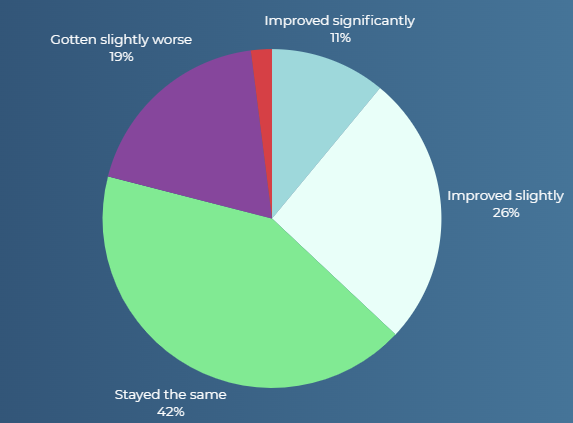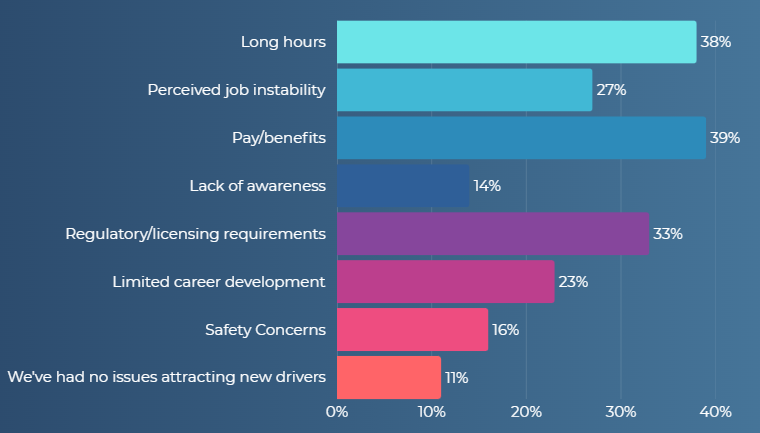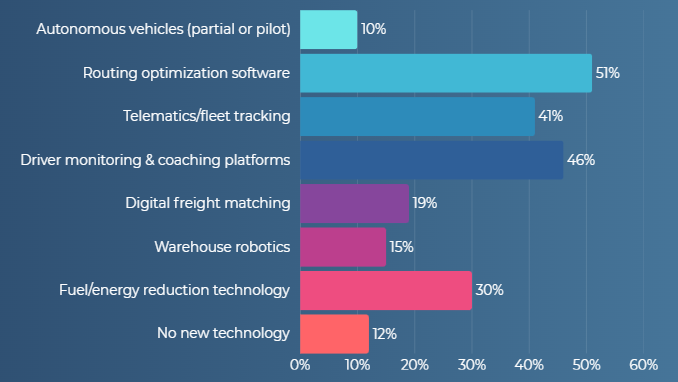In 2025, the state of the US trucking workforce is, unfortunately, not great. A persistent trucker shortage has caused supply chain disruptions in recent years, and signs indicate that the problem is likely to worsen, particularly in light of shifting driver expectations.
All is not lost, though, especially for businesses that stay up-to-date on the latest trends and are proactive about making meaningful changes to their workforce planning. Luckily, we’ve put in the leg work to give businesses the information they need to do just that.
The Moving Goods with Fewer Hands 2025 logistics report from Tech.co provides valuable insights that businesses can use to understand the pain points of the industry and find viable solutions to stay competitive in the long run.
A System Under Pressure
We won’t mince words; the logistics industry could be in trouble in a few years. Our survey found that a large majority of businesses are already quite close to their breaking point, with 85% of respondents noting that they are operating at near full capacity.
To make matters worse, hiring has become a lot harder with the increased demand. 69% of businesses say that trucker shortages have had an impact on their ability to haul freight, and 63% of businesses state recruitment and retention efficiency has worsened or stayed the same in the last year, with 2% saying that it has gotten significantly worse.
Small fixes can help, but, suffice to say, this demand isn’t going to be met by the workforce in its current state. And given that 91% of respondents agree that the US economy depends on fast, affordable, reliable freight movement, there could be some long-lasting implications to fleet revenue and reputation if something isn’t done.

How has your ability to recruit and retain drivers changed in the last 12 months? Source: Tech.co
Where Are the Struggles Most Severe?
Owner-operators are feeling the most pressure from the trucker shortage, with 49% of respondents noting that their ability to recruit and retain drivers has stayed the same over the last year, compared to 39% of fleet managers.
While the trucker shortage is and will continue to impact businesses and individuals across the country, there are some states that are more impacted than others. In fact, according to our research, Florida has the highest rate of businesses that have seen no change in their ability to recruit and retain drivers. Here’s how some other states compared:
- Florida – 9%
- California – 8%
- Washington – 7%
- Illinois – 6%
- New York – 6%
- Oregon – 6%
- Pennsylvania – 6%
Some states are getting hit harder than others, but this data also shows that very few are completely shielded from the supply chain impacts of the dwindling logistics workforce, which means addressing the problem can’t be a state-by-state solution.
What Does the Workforce Want in 2025?
Part of the trucker shortage problem is that competent drivers just aren’t applying in 2025. 45% of logistics businesses explained that a lack of qualified applicants is the biggest challenge in maintaining a steady trucker workforce.
It’s not all on the pool of potential drivers, though; businesses need to do more to incentivize workers to apply. 39% of potential applicants noted in our survey that low pay was a significant barrier to entering the industry.
Other factors include long hours (38%), regulatory burdens (33%), job instability (27%), and limited career development (23%), showing that increasing wages isn’t going to be enough to address the workforce needs of the logistics industry.
Perhaps more notably, only 11% of businesses said that they have had no issues at all attracting new drivers, the lowest percentage across our research.

What are the primary barriers to attracting new drivers into the workforce? Source: Tech.co
How Businesses Are Attracting New Drivers
All of this may come off a bit doom and gloom, but the reality is that there are businesses out there that are weathering the storm with the help of logistics technology. In fact, our survey found that 63% of businesses are currently using technology or automation to reduce their reliance on drivers. More telling is the fact that only a small minority of businesses (20%) have no plans at all to use technology to improve their business.
As for what kind of technology is being used, it’s a bit of a mixed bag. The most widely used tech is route optimization software, utilized by 51% of businesses. Driver monitoring and coaching platforms (46%) are also now commonplace, as is fleet management software (41%), and fuel/energy reduction technology (30%).
It’s clear from the solutions above that businesses are focused on simple, cost-cutting measures rather than groundbreaking innovations like self-driving trucks. In fact, only 10% of businesses said that they are using autonomous vehicles to address the driver shortage, the lowest percentage across the survey. Comparatively, 12% said they are using no new technology at all.

What kind of technology have you adopted recently? Source: Tech.co
Learn More About the US Trucking Workforce
In the trucking business, the last thing you want to be is uninformed. With constantly changing regulations and shifting workforce trends becoming the standard for the industry, being aware of the current state of affairs can be a game-changer for businesses of all sizes.
That’s why Tech.co put together the Moving Goods with Fewer Hands 2025 logistics report, with hopes of providing businesses with the valuable insights they need to stay ahead of the curve and make informed decision that will improve their business in the long run.
The report is now live and available in full, and you can download it now by clicking the link above. And make sure to check back at Tech.co on a regular basis to get access to helpful guides and insightful news updates that will ensure the success of your business for years to come.

